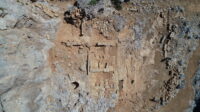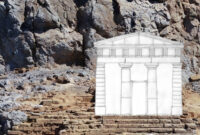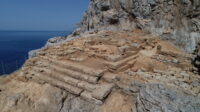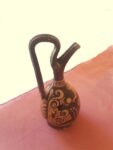 Excavations of the ancient city of Phalasarna in western Crete have unearthed hundreds of offerings to the goddess Demeter in the remains of an ancient temple. The temple dates to the late 4th century B.C. and was built in Doric style on natural rock with two fluted columns, capitals, metopes and pediment. Estimates indicate it was more than 25 feet high and 16 feet wide. It is the only temple of its kind in Crete.
Excavations of the ancient city of Phalasarna in western Crete have unearthed hundreds of offerings to the goddess Demeter in the remains of an ancient temple. The temple dates to the late 4th century B.C. and was built in Doric style on natural rock with two fluted columns, capitals, metopes and pediment. Estimates indicate it was more than 25 feet high and 16 feet wide. It is the only temple of its kind in Crete.
 The temple was built at the junction of two mountain peaks where a natural cave was formed. The cave had abundant water and archaeologists believe an Archaic temple dedicated to a chthonic (related to the Underworld) deity was built there before 650 B.C. It was destroyed when the cave collapsed. Another temple was built in the 6th century, but it was destroyed in an earthquake. Then in the 5th century another was built and you guessed it, it too was destroyed. The last attempt was the 4th century temple.
The temple was built at the junction of two mountain peaks where a natural cave was formed. The cave had abundant water and archaeologists believe an Archaic temple dedicated to a chthonic (related to the Underworld) deity was built there before 650 B.C. It was destroyed when the cave collapsed. Another temple was built in the 6th century, but it was destroyed in an earthquake. Then in the 5th century another was built and you guessed it, it too was destroyed. The last attempt was the 4th century temple.
The remains that are present today were from a reconstruction of the temple after the cave collapse. The perimeter of the enclosure is still in place, as is a monumental staircase leading to two buildings with a shared wall between them. The eastern building was the primary temple.
The sanctuary of the temple had a tiled floor, as did the rest of the floors of the temple. On the floor were five offering cases, inside which were revealed vases of good quality with elegant shapes, some of ceremonial character, one of which was inscribed in the Doric dialect with the name of the goddess to whom the temple was dedicated: A K E S T O I D A M A T R I , Akestoi dedicates to the goddess Demeter. […]
The rocky areas and the ancient deposits in excavated pits revealed findings mainly from the Archaic times. Daedalic art seems to dominate the early Archaic period (650 BC) in the form of nude female figures with Daedalic headdress and high pole. From the findings of the 6th c. e.g. Egyptian and Phoenician glass objects, terracotta bird and animal figurines, arrowheads and spearheads, miniature vases, enthroned female figures, and a female figurine holding a poppy and pomegranate stand out. Regarding the findings of the 4th and 3rd c. BC the hydriai stand out, a beaked ritual prochos with a red representation of a flying Cupid, iron spikes and alabaster vessels.
This was a physically challenging dig. The remains are on a high, rocky hill overlooking the sea. Archaeologists had to build a road to even reach the dig site, and then had to dig as quietly as possible so as not to trigger falling stones from above. The site itself was covered with rocks that the team had to remove with crowbars.
 Phalasarna was settled going back to the Minoan period (3500 B.C. – 1100 B.C.). Its natural harbor made it an important stop in the maritime trade routes of the Aegean and Mediterranean. It reached its peak of prosperity in the 4th century B.C. when the monumental harbor was built. It consisted of four towers linked by defensive walls and quays. The enclosed harbor was connected to the sea by two channels, a shallow one for small boats, a deeper one for larger vessels.
Phalasarna was settled going back to the Minoan period (3500 B.C. – 1100 B.C.). Its natural harbor made it an important stop in the maritime trade routes of the Aegean and Mediterranean. It reached its peak of prosperity in the 4th century B.C. when the monumental harbor was built. It consisted of four towers linked by defensive walls and quays. The enclosed harbor was connected to the sea by two channels, a shallow one for small boats, a deeper one for larger vessels.
 The ancient city was destroyed in 67 B.C. by Roman forces under Pompey Magnus (then not yet Magnus) tasked with routing out and destroying the Mediterranean strongholds of Cilician pirates. They blocked the two harbor channels by dropping massive blocks of stone into them, and the city was abandoned. In 365 A.D., a massive earthquake, one of the greatest seismic events in earth’s history, raised the west coast of Crete by 30 feet. In an instant the ancient harbor was thrust inland and buried. They would remain hidden under tons of soil until excavations began at the site in 1966.
The ancient city was destroyed in 67 B.C. by Roman forces under Pompey Magnus (then not yet Magnus) tasked with routing out and destroying the Mediterranean strongholds of Cilician pirates. They blocked the two harbor channels by dropping massive blocks of stone into them, and the city was abandoned. In 365 A.D., a massive earthquake, one of the greatest seismic events in earth’s history, raised the west coast of Crete by 30 feet. In an instant the ancient harbor was thrust inland and buried. They would remain hidden under tons of soil until excavations began at the site in 1966.